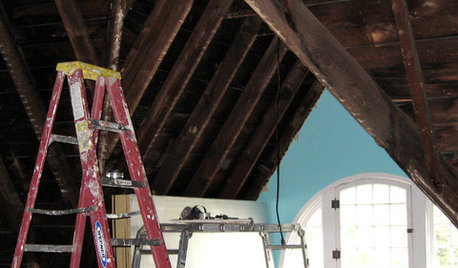Failed well water test - Whole House or One Unit RO Machine ?
kinni G
5 years ago
Featured Answer
Sort by:Oldest
Comments (69)
mxk3 z5b_MI
5 years agobry911
5 years agolast modified: 5 years agoRelated Discussions
Water Softener and Possible RO unit
Comments (18)What we needed to see... PH 7.2 TDS 812 mg/L Total Hardness CaCO3 436 mg/L Sulfate 64.0 mg/L Chloride 234 mg/L Nitrate-N 1.13 mg/L Fluoride 0.609 mg/L Alkalinity, Bicarbonate 264 mg/L Alkalinity Total 264 mg/L Iron/ICP (Total) 0.070 mg/L Calcium/ICP (Total) 139 mg/L Magnesium/ICP (Total) 19.9 mg/L Sodium/ICP (Total) 97.2 mg/L Manganese/ICP (Total) The best news of all... no bacteria and nitrates are very low. You should be testing for bacteria and nitrates every year or two. So, 2 adults, two bathrooms, no water hogging appliances. Looks like a 1.5 cu ft single resin tank softener will do nicely. Plenty of SFR and set up to run efficiently you'll use about one bag of salt a month. Will easily accommodate an increase in occupancy. You could get by with a 1.25 cu ft softener but it's only marginally less expensive. The 1 cu ft softener your local company recommended would be too small and operate very inefficiently wasting salt and water. There is no compelling reason to consider a twin resin tank softener. With your hardness and TDS I'd recommend an RO under the kitchen sink for cooking, drinking, and ice cubes/fridge....See Morehelp! water softener and ro system for my home
Comments (52)Lol. I hear ya. Thanks for pointing that one out to me - I haven't done as much research into RO units as I did the softeners. I guess I'll get an education on how to do some actual plumbing in the next couple weeks... I'm bet the guy used a saddle valve in my basement when he installed my humidifier a year or so ago...I'll check that out. This post was edited by Jlmurph2 on Fri, Apr 26, 13 at 11:03...See Morewhole house water filtration system needed- help suggestions want
Comments (10)@aliceinwonderland_id, i have pasted the results. Where is says nn it represents none noted. it might be hard to read but note the first number is the result, the 2nd is national standard and the last number In each row is the min. detected level. Test results where contamination was detected at or above the min. detection level , but not above the national standard. Heavy metals: results national standard: Min. detection level Calcium 153.9 nn 2 Copper . 0.008 1.3 0.004 Magnesium 7 nn 0.1 Potassium 1 nn 1 Silica 15.4 nn 0.1 sodium 46 nn 1 zinc 0.01 5 0.004 Other: chloride 39 250 5 sulfate 66 250 5 results national standard: Min. detection level physical factors: alkalinity (total as CaCO3) 370 nn 20 Turbidity .2NTU 1 0.1 Radiologicals: Gross beta 4.33PCi/L nn 4 Test results where the contaminant was detected above the standard, which is not an EPA enforceable maximum contaminant level. Heavy metals: results national standard: Min. detection level manganese 0.053 0.05 0.004 physical factors: hardness 410 100 10 TDS 550 1 0.01 (total dissolved solids) hm I assume it's ferrous since the water does come out clear, BUT I have to say that the water in the toilet for instance is also clear. I will investigate tomorrow when I go to the property if particles develop after leaving out a cup of water for a while and I will let you know. pls let me know what you think regarding results. btw I did not include any results that tested fine. thanks in advance!...See MoreLooking for practical whole house water filter for good city water
Comments (11)My suburb purchases its water from Chicago. The water is not considered hard and homes on Chicago water typically do not have a water softener. Over the years, the smell and taste of chlorine has gotten much stronger - either I'm getting more sensitive to it or more is being added to the water. I was using an under-the-sink filter with 2 cartridges and the single cartridge units that are placed ahead of the shower head. When I touched up my main bathroom 3 years ago, I decided to scrap all the separate filters and install a whole house filter. I purchased this one from Discount Filter Store: http://www.discountfilterstore.com/two-housing-filter-system-pentek-bbfs-22.html and two cartridges - one for sediment and one a carbon filter. So far, I've been totally happy with it. I did not notice any pressure drop and no more chlorine taste or smell when taking a shower. The cartridges are cylinders, 20" long and 4.5" in diameter. Together, I paid around $90 for the pair, last time I replaced them. When replacing them, you have to wash out the housing with a chlorine bleach solution and then install the new filters. Because of the size of the housing, that's something best done in a basement laundry tub. Then there's new o-rings and food grade silicone lubricant for the o-rings. Definitely not as easy as replacing the under-the-sink versions, but once installed, every faucet, shower and tub are covered. Unfortunately, also every toilet and sill cock (I didn't have the house re-plumbed). However, since my water usage is low, I only change the filters every 2 years - have only done so once; time to do so again is coming up. Since I have a meter, it's easy to know how much water is used vs. the rating of the filter. I had a plumber install the system for me. He put in a full complement of ball valves such that I can bypass the filters and still have water in the house. I also purchased the special wrench that fits into the grooves of the housing making it easier to remove....See Morekinni G
5 years agolast modified: 5 years agokinni G
5 years agomxk3 z5b_MI
5 years agolast modified: 5 years agokinni G
5 years agosushipup1
5 years agokinni G
5 years agolast modified: 5 years agoJake The Wonderdog
5 years agolast modified: 5 years agokinni G
5 years agolast modified: 5 years agokinni G
5 years agomaifleur01
5 years agoannied75
5 years agoJake The Wonderdog
5 years agolast modified: 5 years agokinni G
5 years agobry911
5 years agolast modified: 5 years agoJake The Wonderdog
5 years agoJake The Wonderdog
5 years agolast modified: 5 years agobry911
5 years agokinni G
5 years agolast modified: 5 years agoJake The Wonderdog
5 years agolast modified: 5 years agokinni G
5 years agoJake The Wonderdog
5 years agoannied75
5 years agoweedmeister
5 years agokinni G
5 years agojmm1837
5 years agoJake The Wonderdog
5 years agolast modified: 5 years agoMule Meat
5 years agokinni G
5 years agoJake The Wonderdog
5 years agomaifleur01
5 years agojmm1837
5 years agoJake The Wonderdog
5 years agokinni G
5 years agolast modified: 5 years agoncrealestateguy
5 years agoUser
5 years agoJake The Wonderdog
5 years agomxk3 z5b_MI
5 years agolast modified: 5 years agoMule Meat
5 years agoJake The Wonderdog
5 years agoMule Meat
5 years agoJake The Wonderdog
5 years agoMule Meat
5 years agoJake The Wonderdog
5 years agolast modified: 5 years agoMule Meat
5 years agoJake The Wonderdog
5 years ago
Related Stories

DECLUTTERING5 Ways to Jump-Start a Whole-House Decluttering Effort
If the piles of paperwork and jampacked closets have you feeling like a deer in the headlights, take a deep breath and a baby step
Full Story
COLORPick-a-Paint Help: How to Create a Whole-House Color Palette
Don't be daunted. With these strategies, building a cohesive palette for your entire home is less difficult than it seems
Full Story
REMODELING GUIDES10 Tips to Maximize Your Whole-House Remodel
Cover all the bases now to ensure many years of satisfaction with your full renovation, second-story addition or bump-out
Full Story
DECLUTTERINGNo Time to Declutter the Whole House? Try These 6 Ideas
Make a fresh start by tackling a few tasks that will revitalize your home and your spirits
Full Story
HOUSEKEEPINGProtect Your House From Winter Water Damage
Avoid costly repairs by learning to spot potential problem areas before water damage is done
Full Story
KITCHEN DESIGN12 Great Kitchen Styles — Which One’s for You?
Sometimes you can be surprised by the kitchen style that really calls to you. The proof is in the pictures
Full Story
HEALTHY HOMEHow to Choose a Home Water Filtering System
Learn which water purification method is best for your house, from pitchers to whole-house setups
Full Story
REMODELING GUIDESCool Your House (and Costs) With the Right Insulation
Insulation offers one of the best paybacks on your investment in your house. Here are some types to discuss with your contractor
Full Story
REMODELING GUIDES8 Lessons on Renovating a House from Someone Who's Living It
So you think DIY remodeling is going to be fun? Here is one homeowner's list of what you may be getting yourself into
Full Story
MODERN ARCHITECTUREMust-Know Modern Homes: Gropius House
Dynamic and sculptural, this New England home refutes a common conception of modern architecture by responding personally to its site
Full Story





bry911